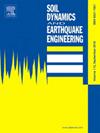Rolling tuned mass damper for vibration control of building structures subjected to earthquakes: A comparative study
IF 4.2
2区 工程技术
Q1 ENGINEERING, GEOLOGICAL
引用次数: 0
Abstract
This study proposes an improved form of a tuned mass damper (TMD) to reduce vibrations in building structures subjected to earthquake loads. Unlike traditional TMDs with sliding motion, the mass element of the new type of TMD proposed in this study is rolling without sliding motion (denoted by RTMD). This motion increases the inertial component, thereby increasing the kinetic energy of RTMDs compared to traditional TMDs. As a result, RTMDs will have a different impact on the dynamic responses of the main structure than TMDs. First, the RTMD's stiffness and damping parameters are optimized as a passive control problem to minimize the peak relative displacement of the main structure. Then, RTMD thoroughly investigated its performance as an active control problem by adding a control force calculated from the Linear Quadratic Regulator (LQR). A TMD with a mass equivalent to the RTMD is also investigated for comparison. The simulation results show that the RTMD is significantly more effective in reducing vibrations than the TMD in the nominal case of the main structure and different cases of main structure stiffness changes, as well as in the case of the structure–damping device system being subjected to different earthquake loads. In addition, in the case of active control, RTMD shows the above advantages and consumes less control power than TMD. These results demonstrated the robustness, stability, and performance of RTMD compared to classical TMDs.
滚动调谐质量阻尼器在地震作用下建筑结构振动控制中的比较研究
本研究提出一种改进形式的调谐质量阻尼器(TMD),以减少建筑物结构在地震荷载下的振动。与传统的具有滑动运动的TMD不同,本文提出的新型TMD的质量元为滚动无滑动运动(简称RTMD)。这种运动增加了惯性分量,从而与传统的tmd相比,增加了rtmd的动能。因此,rtmd对主体结构动力响应的影响与tmd不同。首先,将RTMD的刚度和阻尼参数作为被动控制问题进行优化,使主体结构的峰值相对位移最小;然后,通过添加线性二次型调节器(LQR)计算的控制力,对RTMD作为主动控制问题的性能进行了深入研究。还研究了与RTMD质量相当的TMD进行比较。仿真结果表明,在主结构标称情况下、不同主结构刚度变化情况下以及结构-阻尼装置系统受不同地震荷载作用时,RTMD的减振效果明显优于TMD。此外,在主动控制的情况下,RTMD显示出上述优点,并且比TMD消耗更少的控制功率。这些结果证明了RTMD与经典tmd相比的鲁棒性、稳定性和性能。
本文章由计算机程序翻译,如有差异,请以英文原文为准。
求助全文
约1分钟内获得全文
求助全文
来源期刊

Soil Dynamics and Earthquake Engineering
工程技术-地球科学综合
CiteScore
7.50
自引率
15.00%
发文量
446
审稿时长
8 months
期刊介绍:
The journal aims to encourage and enhance the role of mechanics and other disciplines as they relate to earthquake engineering by providing opportunities for the publication of the work of applied mathematicians, engineers and other applied scientists involved in solving problems closely related to the field of earthquake engineering and geotechnical earthquake engineering.
Emphasis is placed on new concepts and techniques, but case histories will also be published if they enhance the presentation and understanding of new technical concepts.
 求助内容:
求助内容: 应助结果提醒方式:
应助结果提醒方式:


